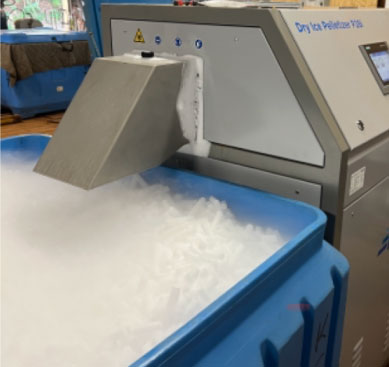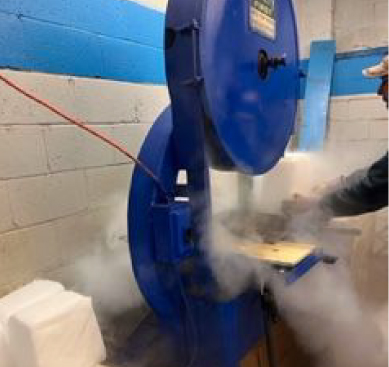
Dry Ice Manufacturing
Kelly Dry Ice manufactures solid dry ice blocks and dry ice pellets daily at our Pittsburgh, Pennsylvania location. This process provides you with the freshest dry ice possible.
Kelly Dry Ice is your go-to Dry Ice manufacturer in Pittsburgh, Pennsylvania producing over 30,000 lbs. of solid dry ice block and dry ice pellets in a day. We are constantly producing and distributing dry ice where it does not sit around, and it is always fresh and on hand.
Kelly Dry manufacturers Dry Ice Blasting Pellets for industrial cleaning. This method of cleaning is very effective and saves time with clean up because the dry ice sublimates into a gas. Contact us for more information on this process and renting blasting machines.

Dry Ice Solid Block
Our state-of-the-art dry ice block machine/press produces 55 pound solid block that is 12 x 12 x 8. Blocks are available whole or custom cut into dry ice slabs/slices.

Dry Ice Pellets
Our pelletizers produce standard 5/8” dry ice pellets (16mm) and 1/8” dry ice blasting pellets (3mm).

Dry Ice Slabs / Dry Ice Sliced / Cut Dry Ice
Kelly Dry Ice provides custom cut dry ice to customer specifications.
Dry Ice Manufacturing Process
Liquid CO2 is piped to our dry ice machines where the liquid enters an expansion chamber. Inside the expansion chamber, the liquid CO2 flashes to gas. The rapid expansion from liquid to gas causes the temperature to drop rapidly and roughly half of the CO2 gas freezes into dry ice snow. The dry ice snow is then compressed into solid dry ice blocks, or into dry ice pellets.
Storing Dry Ice
Don’t store dry ice in air-tight containers. Dry ice can be stored in a picnic cooler or containers made from insulating foam to help slow the rate of sublimation. Fill open space with a cotton towel or newspaper to slow the sublimation. Dry ice will sublimate at any temperature above -109.3° F. The rate at which it sublimates can vary considerably depending on the quantity and form of the dry ice. A small amount of pellets will sublimate much more rapidly than a single large block. Dry ice containers should be kept only in places with good ventilation.
Dry Ice Disposal
Allowing dry ice to sublimate at room temperature is an effective way to dispose of it, but it’s important to take precautions to help prevent hazards.
- Make sure to allow dry ice to sublimate only in well-ventilated areas to avoid a harmful buildup of CO2.
- Do not leave dry ice unattended in public places.
- Never dispose of dry ice in a toilet, sink or garbage disposal. The extreme cold can damage plumbing.
- Avoid putting dry ice directly on tile or laminated countertops. The cold can weaken adhesives and cause cracking.
Dry Ice Frequently Asked Questions
Do you keep a supply of Dry Ice on hand?
Yes. We are constantly producing and distributing dry ice where it does not sit around, and it is always available and fresh.
Can Dry Ice cause carbon dioxide poisoning?
Dry ice can produce carbon dioxide as it turns from a solid to a gas. Carbon dioxide is in the air we breathe, but it makes up only a tiny percentage of it. At high concentrations, it has toxic effects. Carbon dioxide poisoning can be caused by dry ice in enclosed, poorly ventilated spaces.
What are the symptoms of carbon dioxide poisoning?
Rapid breathing is an early symptom of carbon dioxide exposure. Other symptoms of carbon dioxide poisoning are similar to those of oxygen deprivation and include headache, dizziness and drowsiness.
Can I save Dry Ice in my freezer?
No. Dry ice turns to a gas at –109.3° F, so even a freezer will be far too warm to prevent that from happening. A good way to preserve dry ice is in a non-air-tight insulated container such as a chest or cooler, the thicker its insulation the better, stored in a well-ventilated location. Add cotton towels or newspaper to fill open space in the container to slow the rate of sublimation.
How to use Dry Ice for freezing
Place items on bottom of your cooler/container. Cover items with insulating material (i.e. newspaper, cardboard). Place Dry Ice on top of insulating material. Do not allow direct contact of items with the Dry Ice.
How to use Dry Ice for cooling
Place Dry Ice in the bottom of cooler/container. Cover with insulating material (i.e. newspaper, cardboard.) Place items on top. Do not allow direct contact of items with the Dry Ice.
How long will Dry Ice keep and how far in advance can you get it?
You should purchase Dry Ice close to when it is needed. However, if you need to purchase it in advance, you can store Dry Ice in a standard picnic cooler or Styrofoam cooler to help slow the rate of sublimation. Fill the open space with a cotton towel or paper to slow the sublimation. If you need to keep Dry Ice for several days, we recommend getting a little more than you need. Depending on the amount of Dry Ice you have, it can last for several days. (Solid pieces last longer than pellets.) Check out our manufacturing page for more information on storing dry ice.
Can I store Dry Ice in a picnic cooler?
Dry ice can be stored in a standard picnic cooler Styrofoam container to help slow the rate of sublimation. Fill the open space with a cotton towel or paper to slow the sublimation. Check out our manufacturing page for more information on storing dry ice.
Please see our safety instructions when handling dry ice